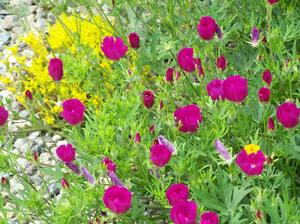
Sun-loving Callirhoe involucrata forms a long-blooming, wide-spreading carpet and thrives in poor to average soil.
Lawns Part II: Organic Lawn Care and the Climax Lawn - Splendor in the Grass
THE DO IT YOURSELF “PERFECT LAWN COMMUNITY”
Organic lawn care is possible. And for those who desire a traditional lawn it is the only sustainable solution. The “perfect lawn community” is yours with a little planning.
To achieve the “perfect lawn community” it is crucial to begin by choosing appropriate grass mixes or lay down pre-grown turf (“sodding”). However, if you lay turf that arrives in rolls know your sources: chemicals may have been employed in their growth. The lawn grasses that grow best for us in northeastern Connecticut are cool-season grasses. The lowest maintenance grasses are Kentucky bluegrass, Rough bluegrass and Perennial ryegrasses, all making fine to medium-textured lawns. Medium-textured Tall Fescue and fine-textured Creeping Fescue require moderate maintenance. Bent grass grows into a fine-textured exhibition lawn (it is used in golf courses) but is high maintenance. A mixture of grasses is the safer strategy; if one species becomes diseased the others will likely remain healthy and green. Seek out a mix that includes a combination of named cultivated varieties (“cultivars”); otherwise, the mix is inferior and should be avoided.
The optimum time to sow seed is late August/early September but you may plant in early to mid spring also. Sow on limy draining soils 6 to 12 inches deep. Wait until the grass is 2.5 inches high then mow it down to 1.5 inches. This will aid in “tillering”, the process by which the sod spreads and becomes denser. Once your new lawn is established mowing to a height of 2 inches will help to keep the grasses strong and the weeds down to a minimum. Cutting your lawn lower can stress and injure grasses. Waiting too long between mowing sessions and you may have to rake the clippings as they may stifle the sod beneath. Strive for this ideal: cut your lawn by one third its height, i.e. allow the grass to grow 3 inches or so then mow it down to a 2 inch height on a regular schedule.
Mulching mowers turn grass clippings into mulch. This debris becomes “sheet compost” filling in the spaces between the grasses. As it breaks down it invigorates the soil creatures which in turn create the nutrients that feed your grasses. Raking in a little garden compost and/or composted animal manures in early spring will provide your lawns with a huge vital boost. Liming at the end of the season with dolomitic limestone is also helpful. This maintenance schedule will supply your lawn with everything it needs and enhance the soil flora and fauna that will aid in maintaining balance. If your lawn is small you could opt for an old-fashioned reel mower. The exercise will be good for you and no greenhouse gas emissions will be good for the environment.
Corn gluten is a gentle, naturally occurring herbicide which replaces synthetic herbicides. Containing compounds which behave as natural weed inhibitors it does no harm to grasses. The corn gluten gradually breaks down and acts as a mild fertilizer. Of course, a small grass patch can be hand weeded. There is a bevy of tools designed for this purpose. All can be found or ordered through local agricultural supply stores, the internet and from mail order suppliers.
THE CLIMAX LAWN: SPLENDOR IN THE GRASS
The wilder solution is the “climax lawn”: the happy, easy-care, casual “country” lawn employing a mix of many plants such as grasses, clovers, prunella, dandelion, potentilla, chamomile, English ox-eye Daisies, Callirhoe (see pic 1), violets (see pic 2), plantains along with early minor bulbs such as Siberian Squill and Snowdrops (see pic 3). And though you might call some among these plants “weeds”, remember: every lovely garden plant we grow was considered a lowly weed at some point in its history. This may be furthest from the perfect lawn but it’s an easy, low maintenance landscape feature; it flowers – hence, it climaxes, it’s attractive and is certainly a natural environment for a host of beneficial insects including many native bees and butterflies. A natural part of the life cycle of many lawn grasses is that most die down and slip into semi-dormancy in midsummer when the weather heats up and drier days set in. Plantains, clovers and violets will often remain green longer during these periods lending fresh color in the lawn. Dutch White Clover often remains green longer in the fall, too.
There are on-line websites and sources that will delve into greater detail than I can impart in the limited space of this column. The organic approach to lawn care reflects an enlightened understanding of the community that lives in and around our lawns and the larger world community of which we are a part. The acceptance of this responsibility mirrors a genuine humility reflected in a respect for life. The golden rule will green your lawn, life and spirit. Stay tuned.
Penned by Wayne Paquette, Winter 2007

